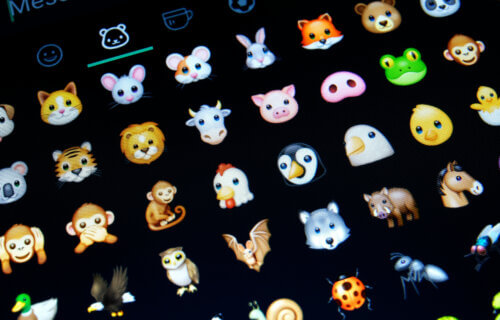MILAN, Italy — There’s seemingly an emoji for everything these days, but don’t tell that to Mother Nature. A new study conducted by a team of conservation biologists analyzed and categorized any and all emojis related to nature and animals, even mapping the tiny digital images onto the phylogenetic tree of life. All in all, researchers say the current emoji “library” is seriously lacking when it comes to an accurate representation of the tree of life and the breadth of biodiversity seen across all of nature.
Emojis are the colorful pictograms sent in countless text messages and iMessages daily. Rising to prominence in the early 2010s, these tiny icons have shown remarkable cultural staying power.
The research team explains that while animals are well represented by the current emoji catalog, plants, fungi, and microorganisms are poorly represented in comparison. More specifically, within the animal kingdom, the biodiversity analysis revealed an overrepresentation of vertebrates and an underrepresentation of arthropods. Scientists argue a more diverse and representative emoji catalog may help facilitate more conversations centered on conservation and biodiversity in the digital era.
“While the biodiversity crisis may seem distant from the online world, in our increasingly digitized society, we should not underestimate the potential of emojis to raise awareness and foster appreciation for the diversity of life on Earth,” study authors Stefano Mammola, Mattia Falaschi, and Gentile Francesco Ficetola explain in the report.
“The development and maintenance of diverse and inclusive emoji sets are crucial to ensure the equitable representation of the tree of life in digital communication tools and to effectively convey messages on the importance of all the organisms for the functioning of the biosphere.”
To conduct this research, the team assessed the taxonomic comprehensiveness of the emoji tree of life. This entailed categorizing all emojis related to nature/animals currently available in Emojipedia (a curated online catalog of emojis), then comparing the emojis’ biodiversity to real-world biodiversity. To ascertain if the emoji catalog had been improving over the years for the better, researchers also took note of changes in emoji biodiversity between 2015 and 2022.
The study identifies emojis representing 112 distinct organisms: 92 animals, 16 plants, one fungus (likely Amanita muscaria), and one microorganism (likely Escherichia coli).
“Currently available emojis encompass a broad range of animal species, while plants, fungi, and microorganisms are underrepresented,” researchers write. “Such strong taxonomic bias is in line with current societal awareness of biodiversity, which tends to prioritize animals over other taxa.”
Then, study authors analyzed biodiversity characteristics among animal emojis in greater detail. Sometimes, they identified individual animal species (for example, the bald eagle and giant panda emojis). Meanwhile, other emojis remained solely identifiable at the genus or family level (emojis that represent ants or crocodilians, etc).

In total, 76 percent of the animal emojis represented vertebrates, and 16 percent represented arthropods. Smaller percentages accounted for mollusks (4%), cnidarians (2%), and annelids (1%). Considering there are 1,302,809 described species of arthropod and only 85,423 described species of vertebrate, researchers explain the current emoji catalog is missing a whole lot of arthropods while carrying a disproportionate amount of vertebrates.
It’s also worth mentioning study authors noted no emojis at all depicting either platyhelminths (i.e., flatworms, including tapeworms) or nematodes. While this may seem like a small omission, consider that there are more than 20,000 platyhelminth species and nearly 20,000 nematode species. These identified biases in the emoji representation of animal biodiversity reflect known biases long seen in many biodiversity assessments and conservation analyses, such as the IUCN Red List, study authors posit.
Alternatively, all this emoji underrepresentation is likely linked to the criteria for judging potential emoji subjects. Researchers explain how in order for anything to become an emoji, it must appear frequently as a searched term on Google. Many unrepresented organisms don’t meet this criterion.
“This rule can be problematic, as it risks hampering the extension of emojis in order to better cover the actual biodiversity of our planet,” researchers say.
On the bright side, emoji biodiversity does appear to be on the upswing. In 2015 there were just 45 emojis for animal taxa, but that number increased to 78 in 2019 and 92 in 2022. Besides just increasing in number, animal emojis have also became more representative of biodiversity over the past few years. Vertebrates, arthropods, and mollusks have had emojis since 2015, annelids gained representation in 2020 (the “worm” emoji), and cnidarians joined the emoji party in 2021 with the red coral emoji.
“This increase in phylogenetic diversity driven by less-known taxa emphasizes a positive trend of enhanced opportunities for emojifying biodiversity communication, allowing users of digital platforms to discuss a range of biodiversity-related topics and sentiments more effectively, beyond the icons depicting iconic species,” the researchers write.
While study authors stress the importance of having access to biodiverse emojis for online discussions of biodiversity and conservation, they also admit further research is necessary in order to properly examine how nature-related emojis influence such interactions.
“Exploring the uses of nature-related emojis in the context of biodiversity communication and conservation could be a topic for further research,” the team concludes.
The study is published in the journal iScience.

Seriously??